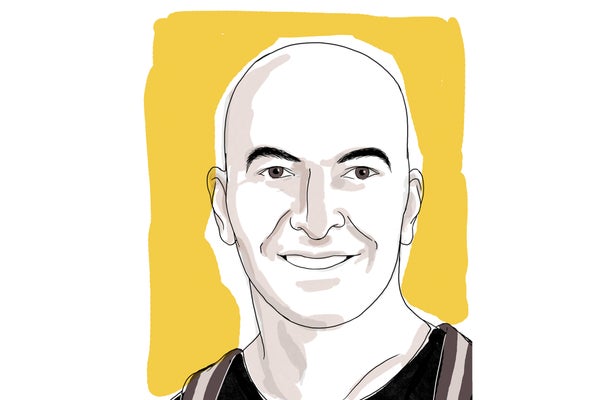Peter Attia has been called a “longevity influencer,” a “wellness trendsetter,” and a “celebrity doctor.”
Whatever the label, it would be hard to find a public figure with a hotter brand in the emerging area of healthspan and longevity science. His 2023 book, Outlive: The Science and Art of Longevity, marketed as a “groundbreaking manifesto” that challenges conventional medical thinking, has sold 1.5 million copies.
The 53-year-old physician, who trained at Stanford and Johns Hopkins, has become the popular face of the growing trend in medicine towards preventive measures to extend the period of time people can live free of chronic disease. Through his company Early Medical, Attia practices what he calls Medicine 3.0, which entails quantifying and measuring the factors that can improve healthspan, including basic “blocking and tackling” like exercise, sleep and stress management, as well as off-label uses of longevity drugs like rapamycin.
Scientific American Custom Media’s Adam Piore spoke with him about his own intellectual journey and what a middle-aged couch potato might do to remain spry until the minute he drops dead of old age.
SACM: Was there a moment when you realized that there was another way to look at medicine rather than just treating chronic disease after symptoms appear?
ATTIA: One of the first realizations, more than a decade ago, was that there’s more to longevity than just living longer. Modern medicine tends to fixate on lifespan, but half of the longevity equation is on the healthspan side.
In reading the literature on centenarians, [I realized] that living longer is mathematically equivalent to delaying the onset of chronic disease. If you want to live longer, you have to make sure that if and when you get heart disease, cancer, neurologic disease, diabetes and so on, you get them much later than the average person.
Why has modern medicine done such a poor job on healthspan?
For me, it comes down to the definition. The modern system of medicine defines healthspan as the period of life that is free of disability and disease. But that’s not really helpful. It’s only when you clearly define and measure things that you have a hope of understanding how to improve them. In healthcare, what gets measured gets managed.
Healthspan can be broken down into three buckets: physical performance, cognitive performance and emotional health. Physical performance is going to come down to freedom from pain and certain metrics of strength, cardio, respiratory endurance, muscular endurance, peak anaerobic output, power, reactivity, flexibility and balance. On the cognitive side, similarly, there are lots of very clear ways that you can measure things: short-term memory, visual-facial memory, long-term memory, olfactory function, executive function, processing speed, crystallized intelligence, fluid intelligence. We have tests for all these things, so we can benchmark people and see what we can do to improve.
Emotional health would clearly be the least objective of the three, but it’s certainly no less important. It comes down to happiness, a sense of purpose and quality of relationships.
Do you need a doctor to embrace healthspan medicine?
In many cases, it’s going to be patient-directed. At some point, that person is going to have to merge with the healthcare system. So, for example, a patient says, “I need a doctor who’s willing to check my apoB [a protein that plays a key role in the metabolism of the particles that carry cholesterol and triglycerides through the bloodstream]. And if it needs to be adjusted, I might need pharmacology.”
How would you recommend finding a doctor willing to practice this way?
I would ask the doctor you’re considering point blank, what is your approach to Medicine 3.0? Do you even know what it means? How do you think about prevention instead of reaction?
We know that there are other physicians out there who have bought my book or worked through our courses, and they’ve said, “Look, we’re trying to put these principles of Medicine 3.0 into practice ourselves.” Our hope is that with each passing day, more and more physicians are taking the time to reeducate themselves so that indeed they can provide that same level of care.
What do you think about anti-aging drugs like rapamycin, metformin, plasma transfusions and others?
We could say with a very high degree of confidence that rapamycin clearly lengthens the lifespan and improves the healthspan of virtually any animal model it’s tested in. Of course, a big question is whether it’s going to do that in humans. We’re not going to get a direct answer to that question, because the challenge of this field is, how do you test these interventions in humans? How do you test something when your ultimate goal is to understand the impact on length of life over several decades?
When you look at the breadth of information, the understanding of the mechanism of action, the nuance around the varied species that have comparable results in the limited human literature, I would say that rapamycin has crossed a threshold. But it’s still not at the point where I would prescribe it to a patient without a lengthy discussion. I am less optimistic on metformin. It doesn’t rise to the threshold, though it’s a beneficial drug, obviously, for someone who’s insulin-resistant or has type 2 diabetes.
What about other drugs?
The class of drugs known as SGLT2 inhibitors [that reduce glucose levels] probably holds some promise. It’s very early days, but it’s also possible that we’re going to see zero protection, meaning benefits above and beyond the obvious thing that they are doing with respect to glucose control. A very promising study looked at a drug that blocks interleukin 11; it had quite profound results, and I would love to see that replicated and expanded upon. It would make sense that transient blunting of the immune response could be very beneficial to aging.
But frankly, for most of the things out there, the evidence is overwhelming that they have zero protective benefits whatsoever. It’s a pretty short list of things that are really interesting.
How do you decide what is snake oil and what is real?
At Early Medical, we work really hard at this. We’ve got an enormous team that works on all of this stuff. You have to look at the sum total of the data. If you’re talking about a specific intervention, like a supplement or a drug, you have to look at: How robust are the animal data? How robust are the human data? What is the data for safety? What is the data for efficacy? What is the mechanism of action? You have to go through a very rigorous approach, because the truth is, most things that are proposed as either zero protective or just vaguely, in a hand-waving sense, good for you turn out to be total and utter nonsense at that and, in some cases, actually harmful.
What should the average person do?
Everything that you and I just spent the last few minutes talking about—whether it be supplements or drugs—is rearranging the deck chairs on the Titanic. People shouldn’t be thinking about any of this nonsense. You have to earn the right to waste time thinking about that stuff, and the way you earn the right is to [first] do the basic blocking and tackling—which, honestly, people don’t want to do because it’s hard and it takes time.
If people actually want to live longer and better, they need to exercise in a very specific and dedicated manner. They need to stay in energy balance. They need to maintain glycemic control. They need to pay very close attention to how they sleep and manage stress. That is 80 percent of it right there.
You exercise a lot more than what most doctors usually recommend. You walk up hills with weights in a backpack. You spend hours every day training. What about people who can only train, say, half an hour a day?
I promise you that if you were to spend half an hour a day really focusing on how you exercise, you would get far more benefit than you would get by taking a drug like metformin right now.
Explore the emerging science of healthspan in other stories in this special report.



